Eye Health and Preventive Care Guide
Home /
Last Updated:
You are accustomed to visiting your eye doctor when you are struggling with your vision. A quick checkup and new prescription can help you update your glasses or contacts, so the world comes into focus once again.
Table of Contents
But during your visit, your doctor is doing more than checking your sight. Your doctor is also performing preventive care.
Not only can routine checkups uncover standard vision issues, but they can also reveal health problems that can significantly impact vision, your overall health, or both.
In this guide, we’ll talk about some common eye health conditions your doctor might assess, including:
- Age-related macular degeneration. This painless condition can steal your sight in small, unnoticeable steps. A dilated exam can help your doctor see it early, when it’s easier to treat.
- Cataracts. Clouded lenses can lead to blurred or double vision. Your doctor can spot them with an exam, and if needed, your doctor can refer you to a surgeon for treatment.
- Glaucoma. A loss of peripheral vision characterizes this disease. Your doctor can identify it with a dilated exam. While there is no cure, your doctor can start treatments to slow disease progression.
- Diabetic retinopathy. Routine exams are critical for people with diabetes, as high blood sugar levels can damage eye blood vessels and lead to blindness. Your doctor can detect the issue with an exam, and they can help you learn how to keep tighter control over your blood sugar.
Most people need to visit an eye care professional every year for exams and screenings. But if an issue runs in your family, you might need to visit the doctor more frequently for complete protection.
Refractive Errors
Light enters the front of your eye, and it’s aiming for delicate nerve tissue that lines the back of the eyeball. A refractive error bends or twists the light, so it can’t hit the target. Blurry vision results.
Refractive errors are common. About 11 million American adults need some type of vision correction, says the Centers for Disease Control and Prevention (CDC).
You deserve clear vision. We can help.
With 135+ locations and over 2.5 million procedures performed, our board-certified eye surgeons deliver results you can trust.
Your journey to better vision starts here.
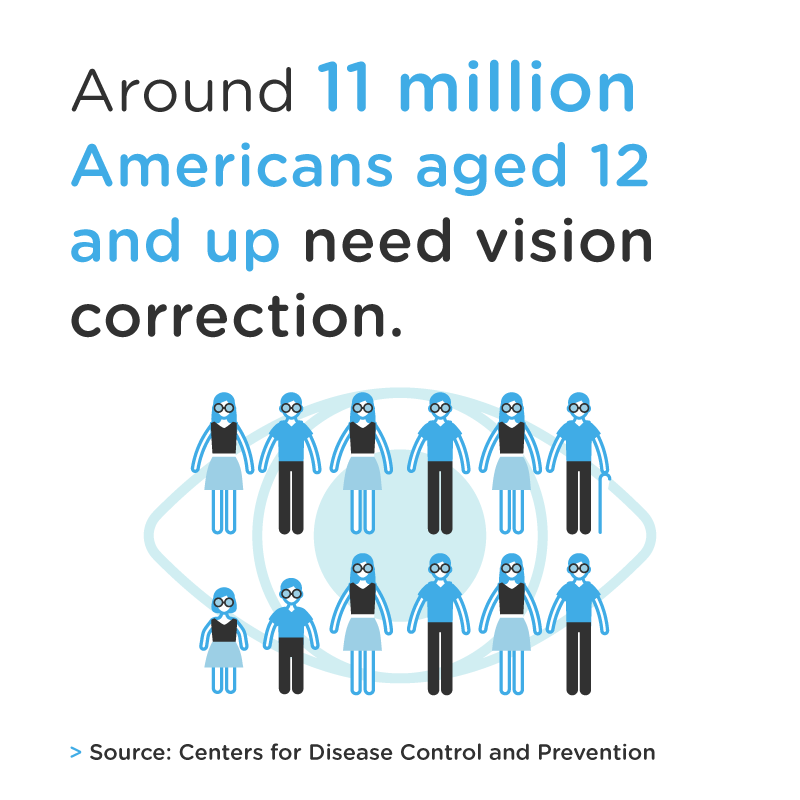
Common vision problems include:
- Myopia. This condition causes nearsightedness. Objects close to you are in sharp focus, but things far away seem blurry.
- Hyperopia. This condition causes farsightedness. You can see things far from you, but items close to you look blurry. People with advanced cases have consistently blurred vision, no matter whether things are near or far, says the National Eye Institute (NEI).
- Astigmatism. This condition causes distorted vision at all distances.
- Presbyopia. This issue impacts people 35 or older. It becomes difficult to focus on items close to you.
Refractive errors are diagnosed by an eye care professional, such as an optometrist or ophthalmologist. The eye doctor tests your vision with a vision chart and a series of lenses to ensure you get the best prescription.
Refractive errors are often corrected with eyeglasses or contact lenses. In some cases, patients may choose refractive surgery, such as LASIK.
Age-Related Macular Degeneration
As its name implies, age-related macular degeneration (AMD) is a condition that can be brought on by merely growing older. But it can start earlier than you might think. The American Foundation for the Blind says people in middle age have a 2 percent chance of developing AMD. People 75 and older, however, have a 30 percent AMD risk.
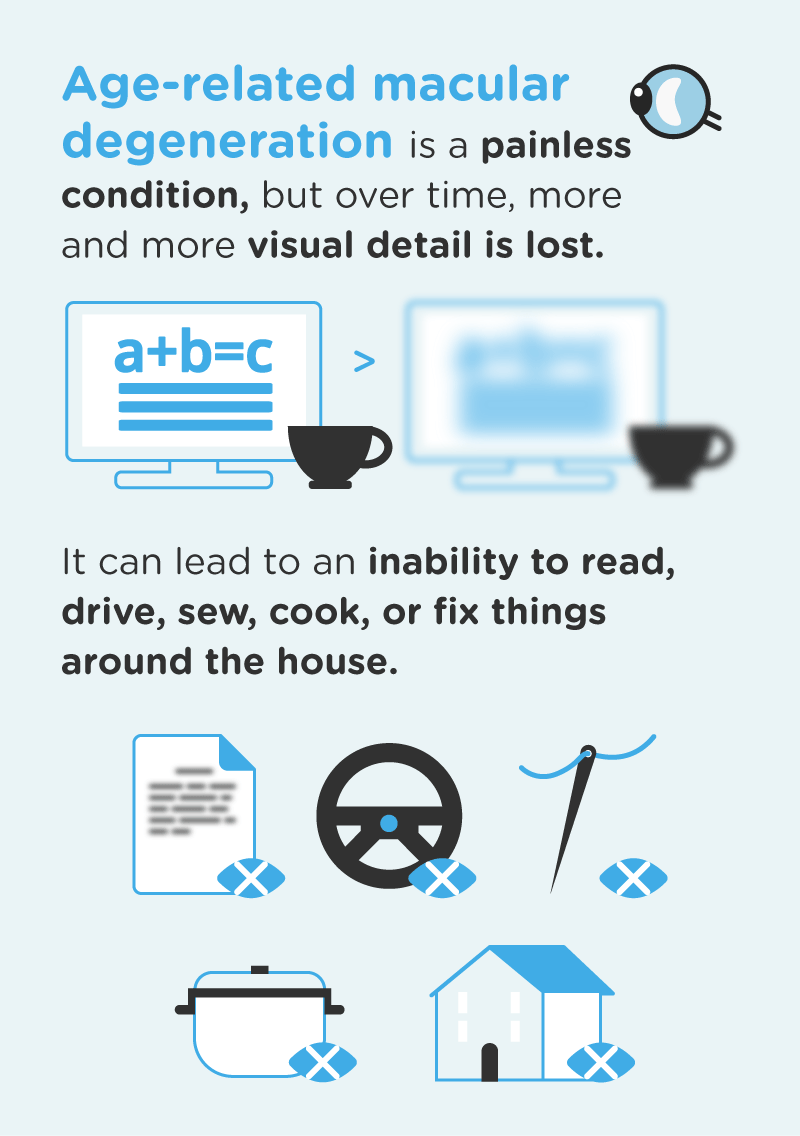
AMD is the top cause of vision loss among people 50 and older, says NEI. So it’s critical for you to get checked often. AMD is easier to treat when caught in early stages.
AMD harms the macula (the part of the eye that allows you to see fine detail). There are two main forms of the disease:
- Dry AMD, in which the macula thins and develops speckles of protein. This is the most common AMD type, says the American Academy of Ophthalmology, as 80 percent of people with AMD have this form.
- Wet AMD, where blood vessels grow beneath the retina. They leak fluids, which damages the retina.
AMD is often painless, but over time, more and more visual detail is lost. It can lead to an inability to read, drive, sew, cook, or fix things around the house.
As the early stages of AMD are often symptomless, it can go undetected for a long time. A comprehensive eye exam is the only way to detect this condition, and this type of exam should be part of everyone’s routine health care plan. A dilated eye exam involves eye drops that widen the pupil, which allows doctors to check the back of the eye.
If you have AMD, your treatment will depend on the type and the severity.
- Dry AMD is often treated with nutritional supplements, such as vitamins C, E, zinc, copper, lutein, and zeaxanthin. These nutrients support the health of the macula tissues. You will also be encouraged to eat a healthy diet that is high in antioxidants.
- Wet AMD is a bit tougher to treat. Your eye doctor may use injections directly into the eye to slow down or stop further vision loss. Other options are photodynamic therapy or laser surgery.
Researchers are also experimenting with complement inhibitors to treat both wet and dry AMD. This treatment is delivered with a needle in a doctor’s office. And while the results are promising, doctors must experiment more before recommending them to everyone.
Cataracts
Your lens, located at the front of your eye, should be clear. When it’s clouded instead, it’s called a cataract. This a common, age-related vision issue. According to NEI, more than half of all Americans will have a cataract by age 80.
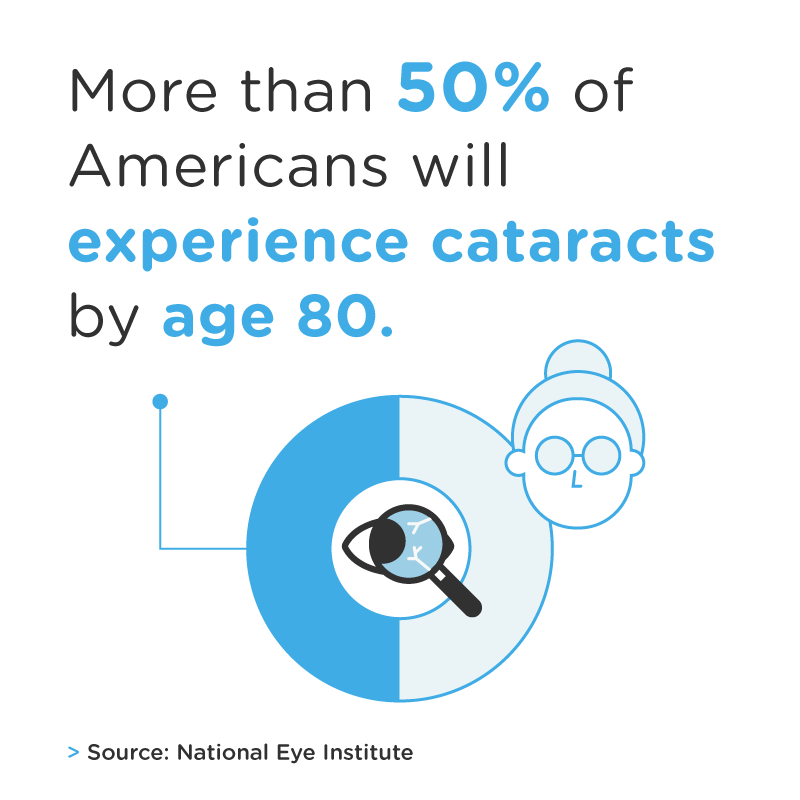
Cataracts can grow in one or both eyes, but the issue does not spread from one eye to the other. Symptoms include:
- Double vision.
- Cloudy or blurry vision.
- Faded colors.
- Glare from light sources.
- Poor night vision.
- Many prescription changes in glasses or contact lenses.
Experts warn that these could be the sign of other issues, so it’s vital to get a comprehensive eye exam when these symptoms appear.
If your cataract is mild and new, your doctor may recommend a few lifestyle changes. Boosting the brightness of your reading light and using a magnifying glass might help.
But cataracts do worsen with time, and Mayo Clinic says they can interfere with your quality of life and your ability to do daily things like driving at night. When that happens, you will need surgery. This is the only way to cure a cataract.
During surgery, the cloudy lens is removed and replaced with an artificial lens. For those who have cataracts in both eyes, they are usually done on separate occasions around a month apart.
You will have your choice of replacement lenses, and sometimes, they can help you see even better than you did before you had a cataract. You could use a monofocal lens to amend your myopia, for example. Or you could use a toric lens, which can help you see both near and far to help with astigmatism.
Your insurance company will pay for a monofocal lens, says Harvard Medical School. But expect to pay $1,500 for each toric lens out of pocket.
You deserve clear vision. We can help.
With 135+ locations and over 2.5 million procedures performed, our board-certified eye surgeons deliver results you can trust.
Your journey to better vision starts here.
Glaucoma
Glaucoma damages your optic nerve, and that causes vision loss. It can even cause blindness.
While glaucoma can’t be cured, treatments can delay the progression. Catching glaucoma early is critical, but the Glaucoma Research Foundation says only half of the people with glaucoma know it.
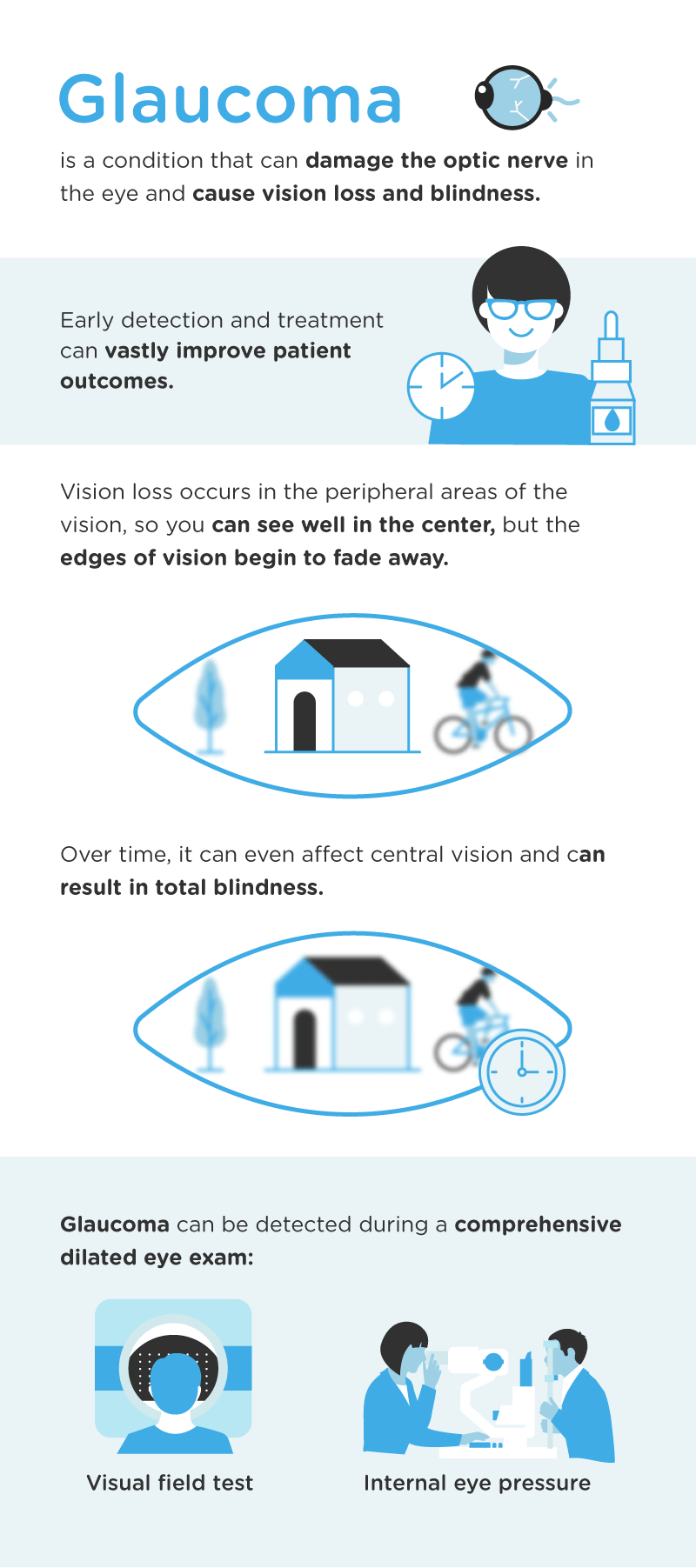
There several different types of glaucoma, says Mayo Clinic, including:
- Open angle. Your eye can’t process fluid properly, so pressure within the eye builds and strangles the optic nerve.
- Angle closure or pigmentary. The iris of the eye bulges and blocks drainage. This can happen suddenly, which is a medical emergency. Or it can develop slowly.
- Normal tension. Your eye pressure remains normal, but your optic nerve is damaged. Researchers do not know why this happens.
- Early onset. Babies can be born with glaucoma, and some kids develop it with the first few years.
Most types of glaucoma cause peripheral vision loss. You can see well in the center, but the edges of vision begin to fade away. Over time, it can even affect central vision and result in total blindness.
But, says Mayo Clinic, the number of people losing all vision due to glaucoma is dropping. In one study, they say, blindness probability dropped about 50 percent in a 45-year timespan. Doctors are catching glaucoma earlier, and they are using innovative therapies to preserve vision.
Your doctor might use:
- Prescription Medication. Eye drops or pills reduce fluid production or help fluid drain the right way. Eye drops are the most common form of glaucoma treatment, says NEI.
- Laser surgery. Your doctor uses a laser to burn holes to help your eye drain better.
- Conventional surgery. Your doctor uses a scalpel to create a drainage network. This surgery is typically performed as a last resort when nothing else worked, says NEI.
As with many other eye problems, glaucoma can be detected during a comprehensive dilated eye exam. Your exam will include a visual field test, which can help your doctor see if you are starting to lose peripheral vision, and your internal eye pressure will be measured as well.
Once vision is lost, it cannot be restored. Discovering optic nerve damage and vision loss early, through a comprehensive dilated medical exam, is crucial.
Diabetic Retinopathy
Diabetic retinopathy strikes more than half of people with diabetes, says the American Society of Retina Specialists. The longer you have diabetes, the bigger your risk.
That is especially true if you do not keep your blood sugar under tight control. Chronically high blood sugar damages very small blood vessels in the retina, and that is the cause of diabetic retinopathy.
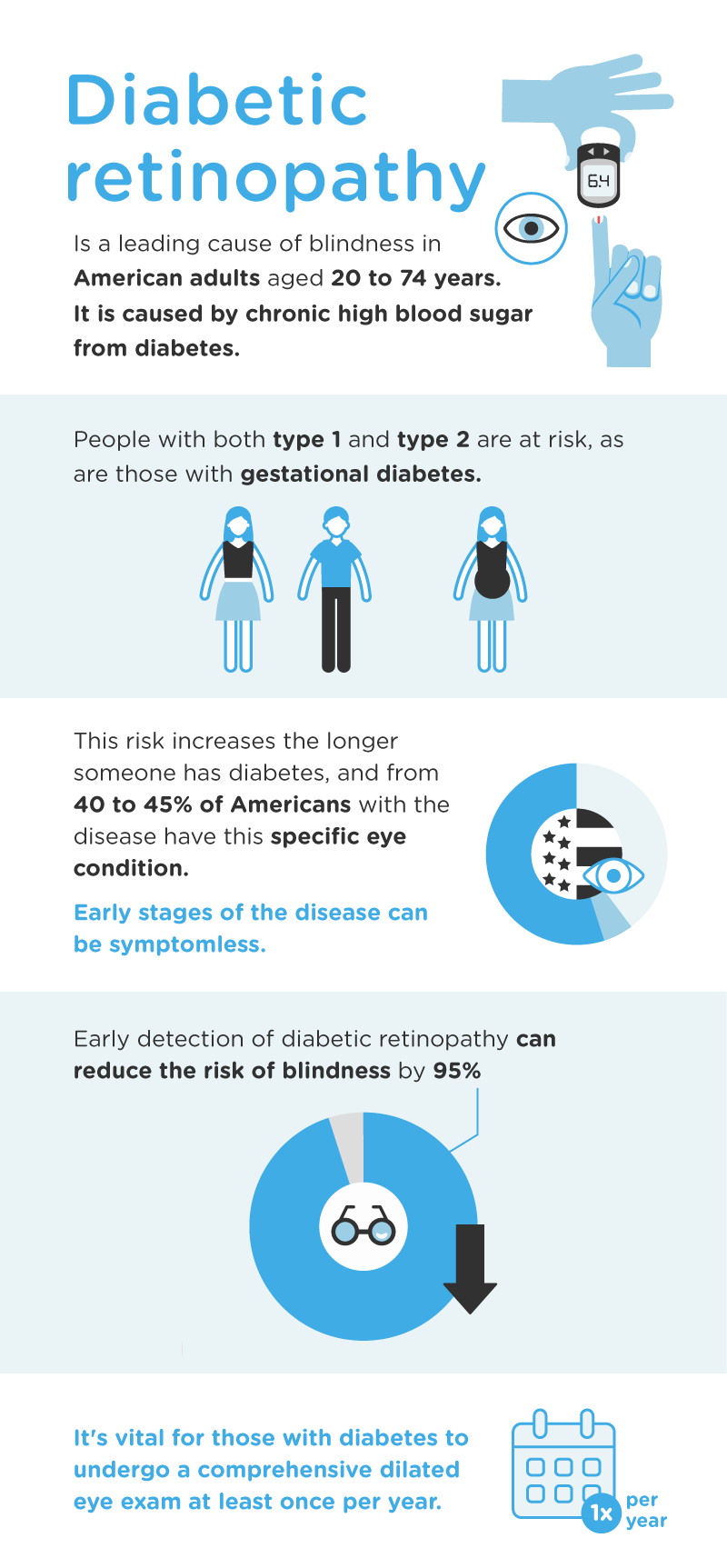
Two main types of diabetic retinopathy exist, says Mayo Clinic.
- Nonproliferative diabetic retinopathy (NPDR): The walls of blood vessels in your retina weaken. They begin to bulge, and sometimes, they leak. Nerve fibers and the center of the eye can swell too.
- Proliferative diabetic retinopathy: This is a more severe form of the disease. You have the same issues found in NPDR, but the eye also develops new and abnormal blood vessels, and they leak into the center of the eye. Your retina can detach, and rising pressure can damage your optic nerve.
Early stages of the disease can be symptomless, which makes it very important to get regular comprehensive dilated eye exams. The National Eye Institute says early detection and treatment can reduce blindness risks by 95 percent.
Your doctor will dilate your eyes to examine the center, the back, and your optic nerve. The test is painless, and it’s often over quickly. If you do have retinopathy, your doctor can refer you to a specialist for treatment.
Your doctor might choose:
- These reduce inflammation and help keep your eye pressure within normal limits.
- Your doctor might place a medication in the center of your eye to stop blood vessels from forming. You will need these shots every month at first, says NEI. But you will need fewer and fewer as time goes on.
- Laser surgery. Your doctor makes several small laser incisions in your eye to slow fluid leaking and reduce swelling. It’s often done just once, but you might need a repeat surgery if the first one didn’t do the trick.
Controlling diabetes, blood pressure, and cholesterol can slow the onset and worsening of diabetic retinopathy.
How Often Should You See the Doctor?
The CDC estimates that the number of blind and visually impaired Americans will double by 2030, so it’s important to make vision care part of your regular wellness routine.
Your doctor can help set up a schedule for you, based on your health and family history. In general, experts say:
- Children should visit an eye health expert at 3 months old, 1 year old, 3 years old, and 5 years old, says the CDC.
- Adults with diabetes should have a dilated eye exam every year.
- African Americans 40 and older should have a dilated eye exam every two years.
- Adults older than 60 should have a dilated eye exam every two years.
- People with a glaucoma family history should have a dilated eye exam every two years.
- People with glasses or contacts should see their eye doctors at least every two years to check the prescription
- Everyone else should have an eye exam every two to five years or so, says the Prevent Blindness organization, on a schedule set by your doctor.
It’s also crucial to make an appointment when symptoms pop up, including reduced vision, eye pain, double vision, halos around lights, floaters, or flashes of light.
To protect your vision, experts also recommend a few key lifestyle changes, such as:
- Wearing sunglasses that block out both UV-A and UV-B radiation from the sun.
- Eating a healthy diet.
- Quitting smoking.
Your eye doctor might have more suggestions, based on your lifestyle, your employer, and your personal preferences.
If possible, form a relationship with one doctor you trust, and stay with that doctor. This professional will know who you are and what you’ve dealt with in the past, and together, you can work toward preserving your sight for a lifetime.
You deserve clear vision. We can help.
With 135+ locations and over 2.5 million procedures performed, our board-certified eye surgeons deliver results you can trust.
Your journey to better vision starts here.
References
- Keep an Eye on Your Vision Health. (July 2018). Centers for Disease Control and Prevention.
- Facts About Refractive Errors. (October 2010). National Eye Institute.
- Three New Techniques for Treating Age-Related Macular Degeneration. (January 2014). American Foundation for the Blind.
- What Is Macular Degeneration? (May 2019). American Academy of Ophthalmology.
- Macular Degeneration Treatments. American Macular Degeneration Foundation.
- New Hope for Treating Age-Related Macular Degeneration. (October 2018). Bright Focus Foundation.
- Can Macular Degeneration Be Reversed? (October 2018). Bright Focus Foundation.
- Facts About Cataract. (September 2015). National Eye Institute.
- Cataract. U.S. National Library of Medicine.
- Considering Cataract Surgery? What You Should Know. (July 2018). Harvard Medical School.
- Glaucoma Facts and Stats. (October 2017). Glaucoma Research Foundation.
- Incidence and Probability of Progression to Blindness Due to Open-Angle Glaucoma Decreases Dramatically. (2014). Mayo Clinic.
- Facts About Glaucoma. (September 2015). National Eye Institute.
- What Is Glaucoma? (November 2018). American Academy of Ophthalmology.
- Diabetic Retinopathy. American Society of Retina Specialists.
- Diabetic Retinopathy: Symptoms and Causes. (May 2018). Mayo Clinic.
- Facts About Diabetic Eye Disease. (September 2015). National Eye Institute.
- Facts About Vision Loss. Centers for Disease Control and Prevention.
This content is for informational purposes only. It may have been reviewed by a licensed physician, but is not intended to serve as a substitute for professional medical advice. Always consult your healthcare provider with any health concerns. For more, read our Privacy Policy and Editorial Policy.
